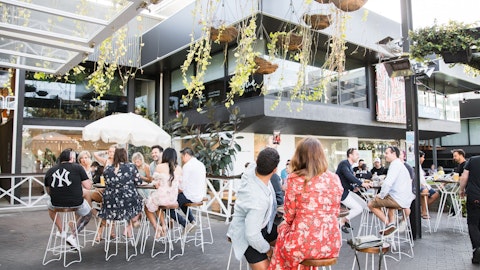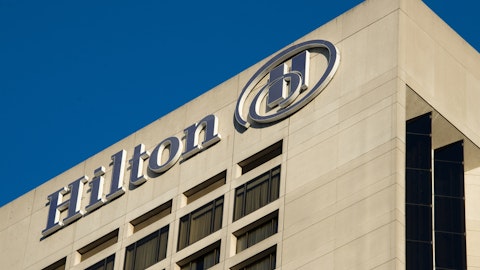Hilton Grand Vacations Inc. (NYSE:HGV) Q4 2022 Earnings Call Transcript March 1, 2023
Operator: Good morning, and welcome to the Hilton Grand Vacations Fourth Quarter 2022 Earnings Conference Call. A telephone replay will be available for seven days following the call. The dial-in number is 844-512-2921 and enter PIN number 13735178. At this time, all participants have been placed in a listen-only mode and the floor will be open for your questions following the presentation. I would now like to turn the call over to Mark Melnyk, Senior Vice President of IR and G&A. Please go ahead, sir.
Mark Melnyk: Thank you, operator, and welcome to the Hilton Grand Vacations fourth quarter 2022 earnings call. As a reminder, our discussions this morning will include forward-looking statements, actual results could differ materially from those indicated by these forward-looking statements and these statements are effective only as of today. We undertake no obligation to publicly update or revise these statements. For a discussion of some of the factors that could cause actual results to differ, please see the Risk Factors section of our 10-K or other applicable SEC filings. We’ll also be referring to certain non-GAAP financial measures. You can find definitions and components of such non-GAAP numbers, as well as reconciliations of non-GAAP and GAAP financial measures discussed today in our earnings press release and on our website at investors.hgv.com.
Our reported results for all periods reflect accounting rules under ASC606, which we adopted in 2018. Under ASC606 we’re required to defer certain revenues and expenses related to sales made in the period when a project is under construction and then hold off on recognizing those revenues and expenses until the period when construction is completed. To help you make more meaningful period-to-period comparisons, you can find details of our current and historical deferrals and recognitions in Table T1 of our earnings release. For ease of comparability and to simplify our discussion today, our comments on adjusted EBITDA and our real estate results refer to results excluding the net impact of construction related deferrals and recognitions for all reporting periods.
A complete accounting of our historical deferral and recognition activity can be found in Excel format on the Financial Reporting section of our Investor Relations website. In a moment, Mark Wang, our President and Chief Executive Officer will provide highlights from the quarter in addition to an update of our current operations and company strategy. After Mark’s comments, our Chief Financial Officer, Dan Matthews will go through the financial details of the quarter. Mark and Dan will then make themselves available for your questions. With that, let me turn the call over to our President and CEO, Mark Wang. Mark
Mark Wang: Good morning, everyone, and welcome to our fourth quarter earnings call. This past quarter was a great finish to a standout year. Contract sales of $634 million remained nicely ahead of 2019 and EBITDA of $253 million was nearly 25% higher than our pro forma 2019 with margins nearly 300 basis points higher. We had a solid contribution from new buyer channels, which has been a key area of focus and investment, with continued strength in leisure demand and good execution from our teams, we’ve been successful at activating our package sales pipeline to drive tour growth, which generates NOG and importantly, embeds future value into the business. I’m extremely proud of our entire team, and what they accomplished in the past year.
We laid the groundwork, for a combined organization through the launch of major programs and integration initiatives. And due to their efforts, we had several milestones faster than we initially modeled, while outperforming our initial underwriting expectations. We’ve also continued to benefit from consumers pivot toward experiences, in leisure travel in particular. And while we’re monitoring the macro environment, our leisure focus and strong value proposition leaves us well positioned for these ongoing shifts in consumer spending preferences. Earlier this quarter, we wrapped up another successful LPGA Tournament of Champions, which was the second held under the HGV brand. We had great attendance during the week, and our media exposure was up dramatically across all channels this year, with social media impressions tripling to over $750 million and active engagements, up six-fold to $1.2 million on top of expanded international television and media coverage.
The tournament also serves, as our marquee Ultimate Access invented a year and we kicked off this calendar with exclusive programming set-up for our members throughout the week. As a result, we generated 40% more tours from the tournament this year with new buyer tours more than doubling versus last year. During the tournament, I spent a lot of time with our owners and guests, and I can say that the energy around our brand and the engagement of our member base is really high which leaves us optimistic about 2023 and beyond. We’re confident in our business, as evidenced by our guidance, and we’re committed to enhancing shareholder value through continued capital returns. Now before I get into the details of the quarter, I’ll start by taking a quick look at what we’ve accomplished over the past 12 months.
It was around this time last year that, I said, 2022 and would be a transformational year for HGV, and that certainly proved to be the case. We launched HGV Max, our new membership offering that links our resort collections and was, also the first major club redesign in our history. We launched HGV Ultimate Access, our exclusive experiential platform and hosted over 100,000 members and guests and over 3,000 events, including private concerts, culinary experiences, shows, excursions and sporting events. We rebranded our sales center, to provide a dramatically improved experience to our marketing guests and trained our sales staff to uphold HGV’s rigorous standards of integrity. We also rebranded Diamond’s largest properties, adding nearly 5,700 keys in new markets like, Sedona, Lake Tahoe, Palm Desert and Virginia Beach.
And we also merged our financial and HR systems and integrated the former DRI teams to unify the organization under HGV culture and values. From a financial perspective, we produced record cash flow and EBITDA exceeding our initial underwriting expectations. We built the largest new buyer pipeline in our history, which will provide a source of tour flow in coming years and embed additional value into the business for years to come. And we achieved an upsized cost synergy goal several quarters ahead of schedule. But equally, as important for our shareholders, however, is that the Diamond acquisition has created real economic value. Dan will get into the details here in a minute, but our cash flow, returns on capital and member base are all well ahead of pro forma combined entity pre-acquisition metrics.
And these improvements were the results of longer-term value creation initiatives like cost efficiencies, process improvement and enhancing our product offerings, rather than just taking outsized pricing. So after a year of hard work, we’ve laid a strong foundation to continue growing the long-term value of the business. Looking forward, 2023 will be a year for further execution of our integration plans. And we’ll build upon the successful launch of both Ultimate Access and HGV Max with new programming and features. We’ll re-brand nearly a dozen additional Diamond properties to add to the Hilton Vacation Club collection. And as we’ve done throughout our history, we’ll maintain our focus on driving new buyer sales and net owner growth. Now, let me take you through a more detailed look at our performance in the fourth quarter.
Contract sales strength was driven by the continued improvement in tour flow, which more than offset the expected normalization of VPG. Tours were nearly 85% of 2019, demonstrating continued progress in our pace of recovery. New buyer tours drove the improvement, showing the positive results from our investment efforts. Additionally, transaction volumes were exceptional this quarter, driven by the tour flow improvements and a close rate that remains near all-time highs. That close rate drove VPGs of $4,350, which remains well ahead of 2019 and decelerated only modestly from the recovery pace we saw in Q3. Turning to the demand indicators. Our system occupancy was 79%, seasonally lower than Q3 and in line with fourth quarter of last year. We saw some softening of occupancy at the end of the quarter that coincided with the holiday airline disruption and unusual storm activity in some markets, but believe that those were isolated issues.
Looking forward, on the book arrivals are nicely ahead of 2019 through the entire first half of 2023, with particular strength in our rental arrivals. I’m encouraged that our marketing package pipeline ticked up slightly from Q3, but more importantly, our number of packages with set travel dates also grew, which will drive additional new buyer tour flow in the months ahead and support net owner growth. We ended the year with 519,000 members and NOG of 3.9% on a combined basis, having grown our member base at both HGV and Diamond throughout the year. This is the highest NOG we’ve generated since we reopened our properties in mid-2020, and I’m really pleased with the results of the investments we’ve made to drive new buyer channel. This combination of new buyer growth and increased member activity drove club and resort revenue to a record $155 million.
And finally, our rental business produced solid revenue results owing to the strong leisure travel environment. To summarize, we feel great about how we closed out a transformational year for HGV. The teams executed against an ambitious and complex plan that involved a lot of heavy lifting, and I’m proud to say we accomplished even more than we anticipated at the close of the acquisition. We’ve built a strong foundation to build upon in 2023 and beyond with our new membership, new programming, new destinations and rebranded resorts we think that our value proposition is the strongest that it’s ever been, which is why we’re seeing such a great response from our owners and new buyers. And we’re continuously focused on creating value for our shareholders through operational improvements of the business as well as a commitment to capital returns.
With that, I’ll turn it over to Dan to talk you through the numbers. Dan?

Copyright: travnikovstudio / 123RF Stock Photo
Dan Mathewes: Thank you, Mark, and good morning, everyone. Before we start, note that our reported results for this quarter included $3 million of sales deferrals, reducing reported GAAP revenue associated with presales of the next phase of our Maui project. We also recorded an associated $2 million of direct expense deferrals, resulting in a net benefit of $1 million to our reported EBITDA for the quarter. In my prepared remarks, I’ll only refer to metrics, excluding the impact of deferrals,which more accurately reflects the cash flow dynamics of our financial performance during the period. We had a very strong 2022 in the midst of a material amount of integration work and major initiative launches. So we’re very proud of everything that the team has accomplished.
Contract sales for the year were a record $2.4 billion and EBITDA of $1 billion was nearly 40% ahead of pro forma 2019 with a margin improvement of nearly 600 basis points to 28%. And as Mark mentioned, we’re extremely proud of the progress we’ve made on our integration and we’ve created real shareholder value with the acquisition. Our 2022 adjusted free cash flow of $563 million was significantly ahead of the pro forma 2019 cash flow. We’ve maintained our exceptional return on invested capital of over 20% and on a much higher capital base, creating additional value annually. And despite several years of the pandemic, we still drove net owner growth ending 2022 with a member base of roughly 25,000 members higher than in pro forma 2019, which will drive additional future value creation.
Now let’s review the results for the quarter. Total revenue in the fourth quarter was just under $1 billion. We saw year-over-year revenue growth in all of our segments, led by strength in real estate and financing segments. Q4 reported adjusted EBITDA was $253 million with margins of 25%. Turning to our segments. Within real estate, total contract sales were $634 million. Sales momentum in our owner channel has remained strong and ahead of 2019 levels. And we also saw a nice jump in the recovery pace of our new buyer channel with sales quickly approaching 2019. We’re pleased with the initial results of the recent investments in our new buyer channel. From the first half of the year, prior to our investment, to the second half of the year, we saw strong improvements in new buyer tour flow and contract sales pace against 2019 that well exceeded the growth from our owner channel and helped to drive solid NOG growth of 3.9%.
We’ve been monetizing our package pipeline and our activated packages are at the highest level since 2019. And our investments should continue paying dividends. As Mark mentioned, we’re seeing very strong arrival growth in our marketing channel as we look out over the coming months. VPG was $4,350 for the quarter, which grew against prior year and 2019. And for the year, VPG finished 31% ahead of 2019. Looking at 2023, as we’ve said for a number of quarters, we expect to see continued normalization of VPG performance against 2019 and as we move through the year. For your modeling purposes, it’s important to note that in the first quarter of 2023, we’re lapping the highest VPG in the history of the company and thus, we anticipate that while VPG will be ahead of 2019, it will decline against that record from Q1 of last year.
Cost of product was 19% of net VOI sales for the quarter. Real estate S&F expense of $243 million for the quarter was 38% of gross contract sales, similar to third quarter levels and reflecting our investments in the new buyer channel. Real estate profit was $172 million for the quarter, with margins of 36%. In our financing business, fourth quarter revenue was $71 million and segment profit was $34 million. I’d note that financing expenses this quarter included a one-time non-cash true-up adjustment to the premium amortization associated with the acquired Diamond portfolio of approximately $9 million. Combined gross receivables for the quarter were $2.5 billion or $1.8 billion net of allowance and our interest income was $65 million. Our originated portfolio weighted average interest rate was 14.3%, while our acquired portfolio had a weighted average interest rate of 15.6% and includes a $6 million contra revenue with the amortization of non-cash premium associated with the portfolio of real receivables that we acquired from Diamond during the acquisition.
Our allowance for bad debt was $742 million on that $2.5 billion receivable balance. Of these amounts, the acquired Diamond portfolio, which used Diamond’s underwriting standards, was $338 million on a portfolio balance of $709 million. Our annualized default rate for our consolidated portfolios, including the Diamond acquired and underwritten portfolios was 7.9%. This is over 100 basis points lower than last year, with both the acquired and originated portfolios continuing to demonstrate substantial outperformance from our initial underwriting assumptions. Our provision for bad debt was $39 million or 9% of owned contract sales, which remains below our steady-state expectations of a normalized provision, driven by higher down payments and continued levels of elevated prepayments.
In our resort and club business, our consolidated member count was 519,000. Our consolidated NOG was 3.9% at the end of the quarter, which I note now includes both HGV and Diamond members. Revenue was $155 million for the quarter and segment profit was $112 million with margins of 72%. Rental and ancillary revenues were $160 million in the quarter with segment profit of $7 million. Fourth quarter margins reflect additional expenses associated with the seasonal effect of member point conversion activity, along with the continued elevated developer maintenance fees associated with the unsold inventory from our recently opened projects. For remodeling, it is important to note that due to the changes made to unify the reporting of HGV and Diamond, there is a timing shift associated with Diamond’s member benefit expense that will cause rental and ancillary expenses in the first half to be up materially versus the first half of 2022.
For Q1 specifically, we expect that this will result in a year-over-year impact of roughly $14 million, which will impact our reported rental and ancillary profit as well as our overall adjusted EBITDA. I’d emphasize that this adjustment is only timing and reflects a change in the seasonality of expenses in the rental and ancillary segment. This year-over-year impact will reverse through the year to become a fully offsetting benefit in the back half and will not itself have any impact to rental and ancillary profit or just adjusted EBITDA for the year. Bridging the gap between segment adjusted EBITDA and total adjusted EBITDA, corporate G&A was $47 million, License fees was $34 million and JV income was $3 million. Our adjusted free cash flow in the quarter was a use of $92 million, which included inventory spending of $73 million and excludes acquisition-related costs of $40 million.
As we mentioned on our prior call, in Q4, we had additional contractual inventory spending for our Sesoko project, along with the payment of our cash taxes, which drove the negative adjusted free cash flow in the quarter. For the year, I’m really happy to say, we generated adjusted free cash flow of $563 million, which is a record for the company. We converted 54% of our economic EBITDA into adjusted free cash flow, which was nicely inside of our 50% to 60% target range, and we expect to maintain this conversion range in the years ahead. It is important to note, however, that in 2023, specifically, we do have an additional just-in-time inventory payment for the Central in New York of roughly $140 million, which includes a payment that was deferred during the pandemic.
Considering this additional payment, total inventory spend for 2023 is expected to be approximately $400 million versus $175 million in 2022. Despite that, however, we still anticipate achieving the low end of our 50% to 60% target EBITDA conversion range. During the quarter, the company repurchased 2.5 million shares of common stock for $100 million, an average price of $39.88. For the year, we repurchased 7 million shares of stock for $272 million. So on top of spending on our integration, funding our growth and paying down our debt we returned nearly half of our adjusted free cash flow to our investors through share repurchases and we’re continuing that trend thus far in 2023. Through February 24, the company has repurchased an additional 1.8 million shares for $80 million.
We currently have $148 million remaining of the $500 million repurchase plan approved by the Board in May of 2022, and we remain committed to enhancing the total return for our shareholders by returning capital. Turning to our outlook. We are setting our 2023 adjusted EBITDA guidance to a range of $1.09 billion to $1.12 billion. Excluding the special reserve release that benefited our third quarter our, guidance implies EBITDA growth of 4% to 7%, which is a great result on top of the strong EBITDA growth we produced this year. Remodeling, I would note that from a seasonal perspective, Q1 EBITDA is typically lower than the preceding fourth quarter and is also typically the lowest EBITDA quarter for the year. Q1 of 2023 will also have the timing impact of the $14 million expense impact in our rental and ancillary segment that I mentioned earlier.
As of December 31, our liquidity position consists of $223 million of unrestricted cash and $959 million of availability under our revolving credit facility. Our debt balance at quarter end was comprised of corporate debt of $2.7 billion and a non-recourse debt balance of $1.1 billion. At quarter end, we had $652 million of remaining capacity on our warehouse facility, of which we had $279 million of notes available to securitize and another $338 million of mortgage notes, we anticipate being eligible following certain customary milestones, such as first payment, deeding and recording. Turning to our credit metrics. At the end of Q4, the company’s total net leverage was 2.4 times. Finally, before we wrap up our prepared remarks, I wanted to address an item that you will be seeing in our 10-K once it is filed later today.
We have identified a material weakness related to Diamond. These items did not impact our business operations or reported processes in any way. They also did not impact our current financial results or our historical results nor will they result in any revision or restatement of historical financials. We already have a remediation plan in place, and we’ll provide additional updates through the year, but we fully expect to have these items resolved expeditiously. We will now turn the call over to the operator, and we look forward to your questions. Operator?
See also 16 High Growth Non-Tech Stocks That Are Profitable and 11 High Growth UK Stocks to Buy.
Q&A Session
Follow Hilton Grand Vacations Inc. (NYSE:HGV)
Follow Hilton Grand Vacations Inc. (NYSE:HGV)
Operator: Thank you. Our first question is from Ben Chaiken with Credit Suisse. Please proceed.
Ben Chaiken: Hey, Good morning. If I’m not mistaken, I think there’s kind of two initiatives underway with the rebrand. I guess one is updating and rebranding the sales centers, which I think you noted on the last call is completed towards the end of 2022. And then second is updating and rebranding the diamond properties themselves. On this first part, the sales centers, is there any type of feedback whether anecdotal or otherwise to help us understand the benefit so far? And then on part two, the property rebrand, have you started to market those properties to Hilton Honors members or is this further down the line? And I have one follow-up. Thanks.
Mark Wang: Yes. Sure, Ben. So on the rebranding front, we basically have rebranded all the legacy Diamond sales centers and implemented our HGV selling technology, our sales approach, our new training. And of course, we’ve now introduced HGV Max and those sales centers. So a lot of heavy lifting, great work by the team to get all that done. As far as marketing into the sales centers utilizing the Hilton database or Hilton’s customer base, we sold 72,000 packages to these locations. And we’re starting to see those tourists now arrive to the property. As you recall, these packages, these vacation packages we sell have a €“ they have a 12- to 18-month window for travel. So we started selling these probably at the beginning of the second quarter of last year.
So we’re starting to see those €“ those guests travel. So we’re starting to see some revenue synergies there. And I think some of the benefits that we’ve seen in our outsized DPGs last year have come through the work we’ve done in repositioning these sales centers and lifting up this new membership program.
Ben Chaiken: Got it. That’s very helpful. And then switching gears a little bit, fee-for-service mix moved higher in the quarter sequentially. I think we €“ I think you called out the pipeline is 85% owned, if I’m not mistaken, in the press release. How do we think about the mix in 2023 and 2024 for that matter?
Dan Mathewes: Hey, Ben, Dan here. Just the easy way to think about it, to your point, most of the inventory that’s coming online is owned. Most of the pipeline is owned. So, I would look for the fee-for-service to decrease in 2023 to be more in that range of 20% to 25%. But that didn’t flows, because obviously when a consumer comes in the door, we take the time to really get to know them and some people are just interested in a deeded product that happens to be fee-for-service. So there is a bit of that play. But with the dynamic of the pipeline being primarily owned inventory, it should decrease to that 20% to 25% range.
Ben Chaiken: Got it. Thank you very much.
Operator: Our next question is from Patrick Scholes with Truist Securities. Please proceed.
Patrick Scholes: Hi. Great. Thank you. Good morning, everyone. A couple of questions here. You had used the adverb on some of your forward trends, the adverb being nicely ahead or nicely the adverb. Can you give more granularity, perhaps in percentages on some of those metrics that you brought up?
Dan Mathewes: Hey Patrick, it’s Dan. Any particular metrics, we
Patrick Scholes: I think you were referring to — I think it was owner visitation and tour packages.
Dan Mathewes: Sure.
Patrick Scholes: I think those were the ones you were referring to?





